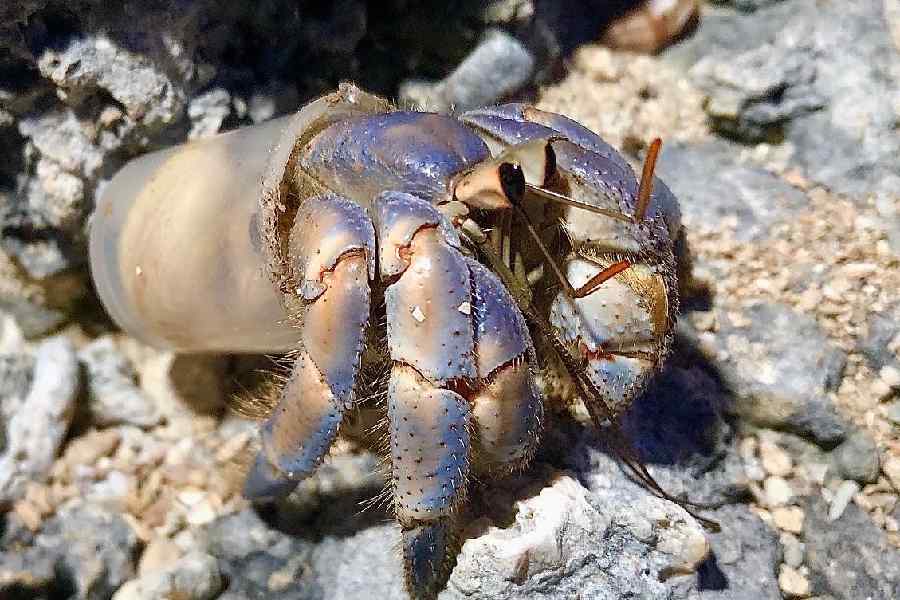How would you feel if you were immersed in the elements, eating and wearing nature, untouched by anything synthetic, and then forced to cover yourself with plastic from trash?
That is perhaps how hermit crabs on beaches across the world feel. Only, they have no voice to speak of their predicament, no means to choose otherwise.
Terrestrial or land hermit crabs are crustaceans living in mangroves, forested areas near the beach, leaf litter, sandy dunes, etc. To understand why they are compelled to wear garbage, one must know why they must “wear” anything at all.

Picture: Shawn Miller.
These crabs have an exoskeleton covering only the front part of their bodies, while their abdomens and tails remain soft and squishy. But smart as they are, they work around this tough absence. They find empty shells of gastropods — slugs and snails — and squeeze their behinds into them, thus protecting themselves from predators. This behaviour of sheltering in borrowed shells also gives them their unique name.
Of course, not all hermit crabs prefer snail shells. Some find homes in bamboo sections, hollow cylinders of wood, nutshells, corals, sponges and so on.
Enter plastics and other waste on the beach, and in oceans and rivers that often wash up along the shoreline. Hermit crabs in these areas are increasingly turning to garbage on the beach — bottle caps, broken bulbs and even metal objects — as armour. “An estimated 171 trillion pieces of plastic currently inside our oceans are wreaking havoc on marine and terrestrial species alike, breaking down into tiny toxic particles and entering organisms’ bodies,” says a report in The Smithsonian from early this year.

Picture: Shawn Miller.
Shawn Miller, a wildlife photographer and naturalist based in Okinawa, Japan, has been documenting animals of the Ryukyu Islands since 2010. In 2014, he started a new project — taking photographs of hermit crabs wearing bits of beach trash — to raise awareness of the problem of polluted beaches. Soon he realised it wasn’t a sight limited to Okinawa’s beaches.
“As time progressed, I started the Make The Switch For Nature (MTS4N) project,” Millers tells The Telegraph over a Zoom call from Okinawa. The project aims to raise awareness about ocean and shoreline pollution, and to help conserve hermit crabs in the Ryukyu Islands. That was in 2020.
While garbage on the beach and in oceans is a glaring issue, there is another aspect to it, he explains. And that is a paucity of natural shells.
“Everybody goes to the beach and takes back shells as souvenirs. That’s a big problem — over collecting. There are no laws to say you can’t pick shells from the beach. But people don’t realise that they are taking away the homes of these animals. And the crabs depend on a variety of them — as they grow they need to move into newer, bigger shells,” Miller explains. And so he began sourcing shell donations via his various social media outlets, and placing them on the beaches of the Ryukyu Islands.
It is amazing how many of such “homes” are in each of our homes. “I have received shells from people around the world. Sometimes they discover a big box in the basement or attic containing shells collected by their grandparents or parents who have passed away,” he says. Again, hermit crabs are a popular pet, especially in the United States. When people buy them, they also buy a box of extra shells for the creature to adapt to as it grows. But when the crab has lived its life, those shells become useless. A lot of these too make their way to Miller’s project. Miller makes sure to clean them in salt water before offering them to the crabs.

Picture: Shawn Miller.
Miller took another more visible step towards increasing awareness. “I started marking some of the shells by engraving ‘MTS4N’ and a number. That way I can track the locations I have placed them in. More importantly, if people happened to spot a crab in a shell with such a marking, it might inspire curiosity and they may realise it’s part of a conservation project. I do this only on turbo shells using a fine tool and without any chemicals.”
What kind of trash homes do these crabs get into mostly? Miller pulls out a large box and places it on the table. There are 159 items in it. Among the trash is a broken glass tube. How could a crab possibly push its body into that, one might wonder. “It’s all based on the size of the hermit crab,” he explains. “They jam and jam their abdomens inside until they feel it is done.”
When he has spotted a crab with a trash home, Miller places a variety of homes — mainly tapestry turban shells of different sizes — on the ground. The crab’s act is a nightly one. “It will decide which shell it wants to go into. It will smell the shell, look at the colour and put its claws inside to gauge the size. Then it turns the shell upside down, rotates it clockwise — so that any sand grain that might be inside falls off — and then shifts itself,” says Miller.
But some crabs have “personalities” — they won’t choose a new home easily. At other times, when he is videographing the switch at night, there’ll be little ones biting at his feet. Says Miller, “But sometimes, they also get used to me because I’m sitting there for an hour.”










